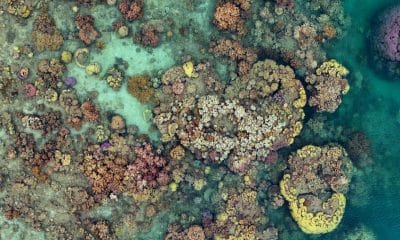News
Great Barrier Reef protection plan report card fails to make the grade

The Queensland government’s Reef Water Quality Protection Plan released its Report Card 2014 on September 21. It states, “Results show the need to accelerate the rate of change and drive innovation to meet the ambitious targets.”
Queensland Environment Minister Steven Miles, who released the report, said there was more bad news than good in the report.
“If one of my kids came home with a report card like this, I’d be a bit disappointed,” he said.
“What is most disturbing is these results are far from our targets, and progress to these targets flatlined in the period 2013-2014. The report does show that progress on meeting our targets had stalled, and that UNESCO’s interest was the right thing; that they were right to be concerned that progress had stalled, because now we know it had,” he said.
The reef report card found despite it avoiding an ‘in danger’ listing from Unesco’s world heritage committee in July, inshore areas are undeniably in a bad shape throughout the 2,300km-long ecosystem..
The report card said that both sea grass beds and inshore coral reefs “remained in poor condition overall”.
While there had been reductions in the amount of chemicals flowing onto the reef from agriculture, the report found only 13% of Queensland sugar cane producers had adopted ‘best management practice’ in terms of nutrients, with only 30% using best practice with pesticides. Only 28% of graziers were managing their pastures properly to protect the reef, the report found.
The report card said 330 hectares of reef wetlands and 30,980 hectares of riverbank vegetation was lost between 2009 and 2013.
“There are some trends that are improving but more needs to be done,” said Roger Shaw, chairperson of the scientific panel responsible for the report card.
“We know the pollutant levels exceed the guidelines so we need to bring them back down. The inshore area is still recovering from major floods we had in 2010 and 2011. Climate change is still the number one threat but I’d add climate variability too — if we have extreme events in a short period of time, there is less capacity for coral to deal with other stressors.”
“The figures in the reef report card represent a clear fail for current programs,” said WWF spokesperson Sean Hoobin.
“Governments have promised to give the reef the clean water it needs to recover by 2025 — to meet this commitment they will need to overhaul current programs, and provide significant additional resources.
“Key first steps are to enforce existing regulations to stop overuse of fertilisers. Leading farmers are showing that it is possible to achieve big reductions in fertiliser pollution while still being profitable.”
The Water Quality Protection Plan needs to be seen within the context of Reef 2050 Long-Term Sustainability Plan (which incorporates water quality).
In a formal response to the Reef 2050 plan in 2014, the Australian Academy of Science stated that the strategy is “inadequate to achieve the goal of restoring or even maintaining the diminished outstanding universal value of the reef”, noting there was “no adequate recognition” of the importance of curbing greenhouse gas emissions.
Professor Terry Hughes, director of the Australian Research Council Centre of Excellence for Coral Reef Studies and an academy fellow, said: “There’s nothing in the plan on addressing climate change. The science is quite clear that you can’t keep the Great Barrier Reef in good condition if you’re going to develop huge coal reserves. We are already on our way to 2°C warming and unless Australia cuts back on carbon dioxide emissions we won’t have much of a Great Barrier Reef left.”
The day after the release of report card 2014 the federal government announced in Cairns the $32 million research hub, which will be led by the Reef and Rainforest Research Centre and James Cook University researcher Dr Damien Burrows, to connect scientists, policymakers and communities to deliver a research program that provides practical solutions to maintaining and improving water quality.
One of the research projects highlighted was the development of a tradable permit scheme for cost-effective reduction of nitrogen run-off in sugarcane reef catchments. Market mechanisms are unlikely to lead to improved water quality. Enforcement of existing penalties against polluters are preferable responses.
The Australian Marine Conservation Society welcomed the federal government’s announcement of the Tropical Water Quality Hub in a September 22 media release, but warned of other dangers, including global warming and “unbridled industrialisation of the Reef”.
AMCS Great Barrier Reef campaigner Gemma Plesman said: “While the Reef Trust will help address water quality, other significant challenges remain.
“The unbridled industrialisation of the Reef presents further risks that will not be addressed with this announcement.
“More needs to be done, including rejecting the coal port proposal for Abbot Point which includes massive amounts of dredging that could put nesting turtles under even greater risk.
“Despite all of the evidence of risk to the Reef, the state and federal Governments are still pushing ahead with their plans for the Abbot Point coal port expansion.
“Water quality is only one piece of the puzzle. Abbot Point presents further risks to this natural wonder.
“The expansion would see 1.1 million cubic metres of the Great Barrier Reef World Heritage Area dredged and then dumped on land adjacent to the internationally significant Caley Valley Wetlands which support 40,000 birds in a good wet season.
“This project would also mean an extra 390 coal ships crossing the Reef each year, increasing the potential for devastating oil spills.
“The Abbot Point expansion would also enable a dramatic increase in the mining and burning of coal which contributes to global warming and places even greater pressure on this fragile ecosystem,” Plesman said.
Source: www.greenleft.org.au
Gear News
Introducing the TR-80, IR-50 and CS-30 Regulators from DYNAMICNORD

Whether you are a beginner or a professional diver – with the three new main regulators from DYNAMICNORD, everyone will find their favourite regulator. They all look super stylish.
Excellent performance with the TR-80
Quality and performance are the be-all and end-all for regulators. It is not for nothing that the TR stands for Tec Reg. The innovative design of the TR-80 guarantees absolute reliability – even in ice-cold waters.

Perfect breathing effort at 0.8 J/l / certified for diving in waters below 10 degrees / structural design made of solid brass for best cold protection / membrane-compensated design with dry seal of the first stage / reduced exhalation effort thanks to optimized exhalation membrane and bubble deflector / adjustable Venturi (dive/predive) and adjustment knob for individual inhalation comfort / innovative design of the front cover prevents free-flow in strong currents or when diving with scooters / design made of sandblasted brass, matt chrome finish / 2 HP and 4 LP outlets / mouthpiece made of high-quality, anti-allergic silicone for maximum comfort.


Amazing underwater adventures with the IR-50
The IR-50 is the top regulator for advanced and experienced divers. Natural breathing is the essence of this regulator.

Ideal breathing effort at 0.8 J/l /certified for diving in waters below 10 degrees / compensated membrane / adjustable venturi (dive/predive) and adjustment knob for individual inhalation comfort/ outlet valve and deflector for minimum exhalation effort and reduction of bubbles on the face / design made of sandblasted brass, matt chrome finish / 2 HP and 4 NP outlets / mouthpiece made of high-quality, anti-allergic silicone for maximum comfort.


The Workhorse – our CS-30
For diving centres and diving beginners – the workhorse stands for strong construction, reliability and robustness. Perfect for your training.

Optimal breathing effort at 0.8 J/l /recommended for diving in waters above 10 degrees / non-compensated piston / adjustable venturi (dive/predive) / outlet valve and deflector for minimum exhalation effort and reduction of bubbles on the face / design made of sandblasted brass, matt chrome finish / 1 HP and 3 NP outlets / mouthpiece made of high-quality, anti-allergic silicone for maximum comfort.


Octopus OP-30
The OP-30 is the ideal addition to all DYNAMICNORD regulators. It is identical in construction to the CS-30.

The TR-80, IR-50, CS-30 (DIN & INT) regulators and the Octopus OP-30 are available from DYNAMICNORD dealers and in the online store.
DYNAMICNORD – Your Outdoor Companion.
Marine Life & Conservation
Paul Watson Released as Denmark Blocks Japan’s Extradition Bid

Renowned anti-whaling activist Paul Watson has been released from custody in Greenland after spending five months in detention. Denmark’s Justice Ministry rejected Japan’s request for his extradition, citing insufficient guarantees that his time already served in custody would be credited against any potential sentence.
The 74-year-old Canadian-American was arrested on July 21 in Nuuk, Greenland’s capital, when his ship docked to refuel. His arrest was based on a 2012 Japanese warrant related to a 2010 encounter in Antarctic waters. Japan alleged Watson obstructed operations and caused damage to a whaling research ship during efforts to disrupt illegal whaling. Watson has consistently denied these claims, maintaining his commitment to marine conservation.
Denmark, which oversees extradition matters for Greenland, concluded that while the legal conditions for extradition were met, the lack of assurances from Japan regarding time-served credit made extradition untenable.
In a video shared by his foundation, Watson expressed gratitude and relief, saying, “After five months, it’s good to be out… and good to know they’re not sending me to Japan.” He added that the most difficult part of his time in custody was being separated from his two young sons.
Watson is a pioneering figure in marine conservation, known for founding the Captain Paul Watson Foundation in 2022 after decades of activism with the Sea Shepherd Conservation Society. His bold efforts to defend marine life have earned him widespread support, including from celebrities and conservationists. His work has also been featured in the acclaimed reality TV series Whale Wars.
Watson’s lawyer, Jonas Christoffersen, praised the decision, stating, “We are happy and relieved that Paul Watson is now free.” He added that Watson is eager to reunite with his family and continue his vital work.
The arrest occurred while Watson’s vessel, the M/Y John Paul DeJoria, was en route to the North Pacific with a team of 26 volunteers to intercept a Japanese whaling ship. His foundation described the arrest as politically motivated and emphasized that Watson’s actions were focused on ending illegal whaling practices.
Japan resumed commercial whaling in 2019 after leaving the International Whaling Commission, asserting that whale meat is a cultural tradition. Conservationists, however, continue to challenge these practices, highlighting their impact on marine ecosystems.
Despite the challenges, Watson remains steadfast in his mission to protect marine life and bring attention to whaling practices. His dedication to ocean conservation has made him a globally respected advocate for the environment.
-

 News2 months ago
News2 months agoIconic SS United States to become the World’s Largest Artificial Reef
-

 News3 months ago
News3 months agoBook Review – 52 Assignments: Underwater Photography
-

 Gear News3 months ago
Gear News3 months agoDYNAMICNORD – New German diving brand enters the British market
-

 News3 months ago
News3 months agoExploring Cenote El Pit: A Diver’s Dream
-

 Gear News3 months ago
Gear News3 months agoTry BARE drysuits (and maybe even win one!) this Friday with Sea & Sea at North West Dive Fest
-

 Marine Life & Conservation3 months ago
Marine Life & Conservation3 months agoBook Review: Coral Triangle Cameos
-

 Blogs3 months ago
Blogs3 months agoDive the Egyptian Red Sea this Autumn with Regaldive
-

 News3 months ago
News3 months ago2024 Ocean Art Underwater Photo Competition Announced















